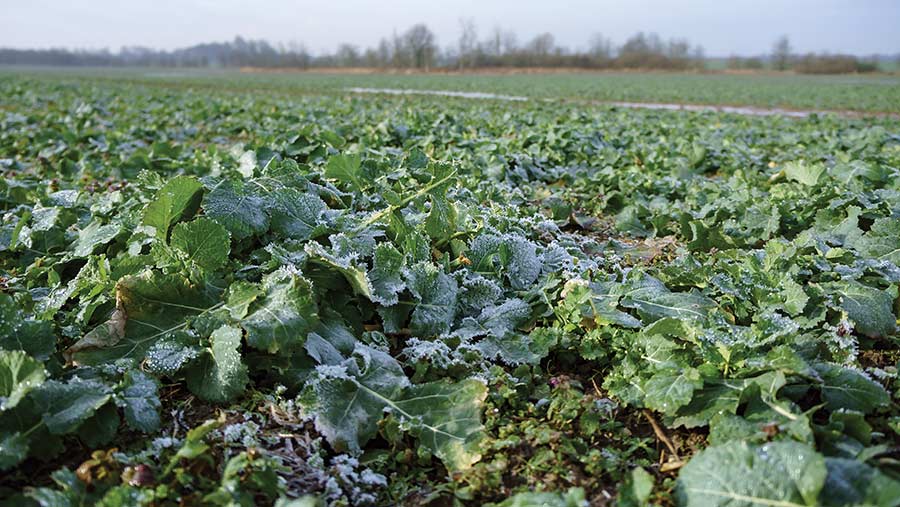Why early OSR drilling may reduce yields by up to 1.5t/ha
 © AdobeStock/Seagull Nady
© AdobeStock/Seagull Nady The trend for milder winters across north-west Europe may mean UK oilseed rape growers need to consider drilling later to maximise rapeseed yields.
A major breeder is investigating whether late September drilling will boost yields, prompted by data suggesting the changing climate is resulting in a lower number of buds being set in early spring.
Speaking at a recent press briefing, Prof Ute Kropf of the University of Applied Sciences in Kiel explained that with oilseed rape, yield is set early in the plant’s development.
See also: What spring crops should farmers consider in 2024?
And the milder winters means this is happening in winter rather than spring.
Dr Andreas Girke, oilseed breeder at NPZ, points to the recommended list trials across Europe, which are seeing an average 2% a year increase in gross output.
However, despite this rising genetic potential, LSPB managing director Chris Guest points out that environmental conditions such as climate stress, new pests and pesticide limitations neutralise it.
Both the UK and Germany have the same yield potential, but the trends are different. There has been a slight decline in on-farm yields in the UK, while there has been an increase in Germany.
New strategy?
So, do we need new crop management strategies such as later sowing in the UK? Is late July/early August drilling a reason for the flatlining yields?
Part of the answer may lie in data from the University of Applied Sciences’ trials site at Lindenhof, near Kiel, in north Germany.
Ute highlights that up to 2014, they had yields of 5-6t/ha, peaking in 2014. Since then, yields have been 1t/ha lower.
She acknowledged the reduction coincided with the loss of neonicotinoid seed treatments, but data at the university also showed that winters have been much milder since 2014 and this was affecting plant development.
In a cold winter with temperatures down to -15C, there is typically two to three months of dormancy. But since 2014, warm winters mean there is only four to five weeks of dormancy with plants more or less growing all autumn and winter. “And they start to regrow much earlier,” she says.
Yield impact
So how does that affect yield? For yield, the key is harvesting more seeds/sq m from plants and that is partly determined by the number of flower buds.
Looking at development, a set amount of thermal time is needed for each pair of leaves and to get to the six-leaf stage takes about 600C of thermal heat. At six leaves, plants enter bud differentiation, which continues up to the 12-leaf stage.
Therefore, at 1,100-1,200C, the plant reaches maximum bud density. After this, the plant starts stem elongation and uses weak side tillers for stem elongation.
In cold winters, crops at Lindenhof in north Germany reach 12 leaves in March. But in warmer winters, plants are at 12 leaves in January after a shorter differentiation stage and start stem elongation having already achieved maximum bud density.
They have a longer stem elongation period with a greater reduction in buds. Furthermore, buds are being formed in poorer conditions when frosts are more likely.
She also notes that stem elongation starts earlier in turnip yellows virus resistant varieties, but is unsure why.
What farmers can do
So how can farmers change their production technique? Do we need different varieties under these conditions? Ute believes late sowing is a viable alternative for the time being.
At Lindenhof, using a normal sowing date of the last week in August means you get to 1,000C by the end of the year. If you delay drilling to, say, 10 September, you get to 800C so eight leaves.
Comparing Cambridge data with the research centre in Kiel for the past two years, Cambridge has seen 230C more thermal time from September to December and 200C extra from January to March.
This equates to an ideal drilling date of 18 or 19 September at Cambridge to achieve the right growth stage by the end of the year.
Chris concluded that early sowing to counter cabbage stem flea beetle problems is changing the crop in terms of yield potential because of thermal time and less harsh winters.
The yield potential loss from too much development is about 1-1.5t/ha, but this needs to be weighed up against the risk of poor autumn weather impeding crop development. And there is still the late summer flea beetle risk.
UK trials
This is why LSPB is carrying out later drilling trials in the UK. At Wisbech, Chris is comparing a market-leading hybrid drilled on 5 September with one drilled on 21 September and there are already notable differences.
There is still a long way to go in getting the answer, but in the meantime, Chris suggests farmers can use their own on-farm weather station data to start looking at thermal time and perhaps work out the latest sowing date.
Impact of milder winters
- Plant growth follows thermal time
- No dormancy over winter
- Bud differentiation ends several weeks earlier
- Earlier stem elongation and reduction of buds under poorer conditions
- Virus-resistant varieties need less thermal time
- How do farmers adapt growing techniques to the changed growth conditions?
- What characteristics should future varieties have?
LS Plant Breeding is the UK-based subsidiary of Norddeutsche Pflanzenzucht Hans-Georg Lembke KG (NPZ), a privately owned plant breeding company based in Germany.

